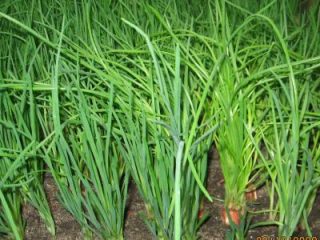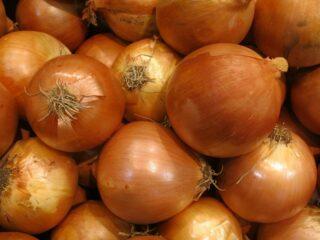Content
- 1 History of variety selection
- 2 Description of the Stuttgarter Riesen bow
- 3 Characteristics of the variety
- 4 Planting and caring for onions
- 5 Growing Stuttgarter Riesen onions from seeds
- 6 Harvest and storage
- 7 Onion propagation methods
- 8 Diseases and pests, methods of control and prevention
- 9 Conclusion
- 10 Reviews
There are many onion varieties in the collections of domestic and foreign breeders, and some of them require special care. The Stuttgarter Riesen onion set is an unpretentious, high-yielding species. Thanks to its features, it is popular not only among Russian gardeners. It is grown on their plots by many plant growers in the near abroad.
History of variety selection
Stuttgarter Riesen is one of the most popular varieties of onions. The high development result was achieved thanks to the painstaking work of breeders of the famous German company “Zamen Mauser Quedlinburg”. To obtain a new product, they used varieties with similar characteristics, highlighting only their best properties. Onions were included in the Russian register of varieties approved for cultivation in the country in 1995.
The Stuttgarter Riesen onion is resistant to the effects of genetic mutations, and its varietal qualities have been preserved throughout its existence. This contributed to its wide distribution. On the territory of Russia, gardeners from all regions are engaged in cultivating the variety; they are attracted by its adaptability to different climate conditions.
Description of the Stuttgarter Riesen bow
Stuttgarter Riesen is a variety characterized by high yield and versatility of use. It is used to prepare fresh salads, a variety of dishes, and canned foods for the winter. Due to the dry matter content, long-term storage in dried or frozen form is possible. Forcing allows you to get healthy young greens.
This is an excellent remedy in the fight against colds thanks to vitamin C, the main element of onions.
Onion sets Stuttgarter Riesen: description
Medium or large onions are round in shape with slightly flattened ends. When ripe, the scales acquire a straw-yellow or golden-brown hue. The taste is pleasant, medium spicy, the smell is strong.
Characteristics of the variety
Stuttgarter is distinguished by high varietal qualities.
Productivity
This is a high-yielding crop of early ripening. The finished harvest is obtained after 10 weeks when the seed is planted in the soil. When grown through sowing seeds, the period increases to 3.5 months.
The average weight of a bulb is 130-150 g. Under optimal growing conditions, it can exceed 200 g.
Due to the high productivity of the variety, 5 kg of onions are harvested from 1 m² with minimal care, and up to 8 kg if all requirements are met.
Resistance to diseases and pests
Stuttgarter Riesen onions have high resistance to diseases and pests.
Advantages and disadvantages of the variety
The description of the Stuttgarter Riesen onion variety indicates positive characteristics, of which it is worth highlighting:
- high productivity;
- early maturation;
- unpretentiousness to planting and care;
- versatility in use;
- undemanding to storage conditions;
- excellent preservation;
- resistance to many diseases and pests;
- the possibility of growing seedlings to produce greenery.
With so many advantages, Stuttgarter Riesen has several disadvantages. Onions are susceptible to rot if it rains often and the weather is damp in the summer. The process of peeling and slicing the onion is inconvenient due to its flattened shape. But, given the many positive qualities, you can ignore such little things.
Planting and caring for onions
The process of planting and caring for Stuttgarter onions is almost the same as with other varieties.
Many gardeners believe that it is more efficient and easier to grow onion sets, so they prefer to use only this method.
Onion planting dates
The favorable period for planting sets of the Stuttgarter Riesen variety is autumn or before winter. It is often planted in the garden in the spring.
When to plant Stuttgarter onions in autumn
In autumn, the seedlings are planted 30 days before the arrival of frost. Carrying out this process in the first ten days of October will allow the vegetable to take root before the temperature drops significantly.
Preparing the bed
The Stuttgarter Riesen onion bed should be located in the sunniest place so that with the arrival of spring the soil warms up faster and the snow melts earlier.
Onions can grow in any soil except acidic soil. But to obtain a rich harvest and large bulbs, areas with fertile soil, black soil or loam are selected.
The soil is fertilized with compost or humus, wood ash and superphosphate to improve its fertility and dug up.
Planting onions Stuttgarter Riesen before winter
Before you start planting Stuttgarter onions before winter, they are sorted and processed. Having gotten rid of rotten, broken and moldy bulbs, they leave samples of the correct shape, without significant damage.
Next, they are heated at a temperature of + 42 °C for 8 hours, using a stove or central heating radiators. This process must be approached carefully so that the planting material does not dry out or overheat, which will lead to a lack of germination.
Many vegetable growers recommend disinfecting planting material in a solution with potassium permanganate or copper sulfate for 10 minutes, followed by daily drying. It is only necessary to take into account that it is easier for dry bulbs to withstand a sharp cold snap than for swollen ones. Also, such actions will help speed up the germination process.
For planting, prepare long holes, the distance between which is 0.25 m. The bulbs are placed there, the distance from one to another should be 10 cm, and lightly watered.
Further care
There are no special requirements for caring for sets of this variety and its updated species, Stuttgarter Stanfield. It is recommended to carry out weeding 2 weeks after planting before the onset of frost.To prevent weak plants from interfering with the development of others, they are removed.
At the same time, the plant is fed with a solution containing mullein or bird droppings and urea. This mixture can be replaced with universal fertilizers purchased at a specialty store. The procedure is repeated after 5 days from the day of the first treatment.
Mulching with peat, sawdust, and dry leaves in a layer of 3 cm or more will protect the onion bed from the first frost.
Growing Stuttgarter Riesen onions from seeds
To obtain a full harvest over the course of one season, vegetable growers use the following proven growing methods:
- Direct spring. The culture is not afraid of a temperature of 5 °C. Sowing seeds in early spring will allow you to get a ripe harvest by the end of the season.
- Podzimny. To prevent the vegetable from sprouting, it is optimal to send the seeds into the ground when the first autumn frosts arrive.
- Growing seedlings in containers. The time for sowing is the second half of February, March. Plants must be provided with additional lighting and all rules of agricultural care must be followed.
To grow Stuttgarter Riesen onions from seeds directly in the ground, dig a bed and cut rows. The distance between them should be 15 cm. Onions are sown pointwise, which will help prevent overspending. To do this, 2-3 seeds are placed in the hole every 10 cm.
Harvest and storage
To prevent onions from overgrowing, do not delay harvesting them. The first sign that it is time to harvest is the wilting and yellowing of the leaves. Full ripeness of onions is the main criterion for storage.
The collected vegetables are sorted and unnecessary roots and leaves are removed. They must be dried on sunny days right in the beds.In rainy weather, leave in ventilated, dry rooms. A properly carried out harvesting process will allow you to preserve vegetables throughout the winter.
Onion propagation methods
Stuttgarter Riesen is not a hybrid, which allows you to obtain seed yourself by planting several bulbs saved from the previous season for pollination among themselves.
Diseases and pests, methods of control and prevention
The vegetable must be protected from onion fly and rot. From the eggs of the pest laid on onion beds, larvae emerge, from which the inside of the turnip suffers. The plant is in danger of rotting and death.
Rot that occurs due to excess moisture is also very dangerous for the crop.
The following are carried out on the rows as preventive measures:
- soaking seed and seedlings in a solution of potassium permanganate and salt before sending them into the ground;
- planting next to vegetables (dill, carrots), protecting onions from pests;
- annual replacement of the place where the variety is sowed (crop rotation);
- timely loosening of the soil;
- autumn digging of the soil, which will lead to the freezing of insects at low temperatures;
- mulching.
Conclusion
If a gardener dreams of growing a good harvest of beautiful, tasty, juicy vegetables, the Stuttgarter Riesen onion set is the most suitable variety for this.
This is possible due to its resistance to weather changes. It is excellent for planting both seeds and sets. Just don’t forget the basic recommendations for growing them, then a good result will be ensured.
Reviews















